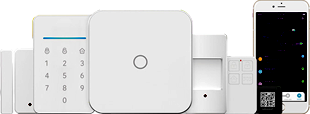What Is Home Automation and How Does it Work?
May 16, 2020
Home automation gives you access to control the devices in your home from a mobile device from anywhere in the world. The term may be used for isolated programmable devices, like thermostats and sprinkler systems, but home automation more accurately describes homes in which nearly everything — lights, appliances, electrical outlets, heating, and cooling systems — are hooked up to a remotely controllable network. From a home security perspective, this also includes your alarm system, and all of the doors, windows, locks, smoke detectors, surveillance cameras, and any other sensors that are linked to it
Home Automation Developments
Until fairly recently, automated central control of building-wide systems was found only in larger commercial buildings and expensive homes. Typically involving only lighting, heating, and cooling systems, building automation rarely provided more than basic control, monitoring, and scheduling functions and was accessible only from specific control points within the building itself.
Automation
Automation is, unsurprisingly, one of the two main characteristics of home automation. Automation refers to the ability to program and schedule events for the devices on the network. The programming may include time-related commands, such as having your lights turn on or off at specific times each day. It can also include non-scheduled events, such as turning on all the lights in your home when your security system alarm is triggered.
Once you start to understand the possibilities of home automation scheduling, you can come up with any number of useful and creative solutions to make your life better. Is that west-facing window letting in too much light? Plug your motorized blinds into a “smart” outlet and program it to close at noon each day. Do you have someone come by at the same time each day to walk the dog? Program your home automation system to unlock the front door for them, and lock it up again when they’re done.
Remote Control
Monitoring apps can provide a wealth of information about your home, from the status of the current moment to a detailed history of what has happened up to now. You can check your security system’s status, whether the lights are on, whether the doors are locked, what the current temperature of your home is, and much more. With cameras as part of
your home automation system, you can even pull up real-time video feeds and literally see what’s going on in your home while you’re away.
Even simple notifications can be used to perform many important tasks. You can program your system to send you a text message or email whenever your security system registers a potential problem, from severe weather alerts to motion detector warnings to fire alarms. You can also get notified for more mundane events, such as programming your “smart” front door lock to let you know when your child returns home from school.
The real hands-on control comes in when you start interacting with the home automation system from your remote app. In addition to arming and disarming your security system, you can reprogram the scheduling, lock and unlock doors, reset the thermostat and adjust the lights all from your phone, from anywhere in the world. As manufacturers are creating more and more “smart” devices and appliances all the time, the possibilities for home automation are virtually limitless.
Home Automation Components
What kinds of things can be part of a home automation system? Ideally, anything that can be connected to a network can be automated and controlled remotely. In the real world, home automation most commonly connects simple binary devices. This includes “on and off” devices such as lights, power outlets, and electronic locks, but also devices such as security sensors that have only two states, open and closed.
Energy Efficiency
One clear advantage of home automation is the unmatched potential for energy savings, and therefore cost savings. Your thermostat is already “smart” in the sense that it uses a temperature threshold to govern the home’s heating and cooling system. In most cases, thermostats can also be programmed with different target temperatures in order to keep energy usage at a minimum during the hours when you’re least likely to benefit from the heating and cooling.
Putting It All Together
We are all busy and home automation may be able to help make things a bit easier for you. Worldwise there are two of the leading home automation security providers are ADT and Vivint, both of which offer different features that can save you time and money. In India, there are few most know companies for home automation along with home security systems like DFS Services.










 Cart (9)
Cart (9)